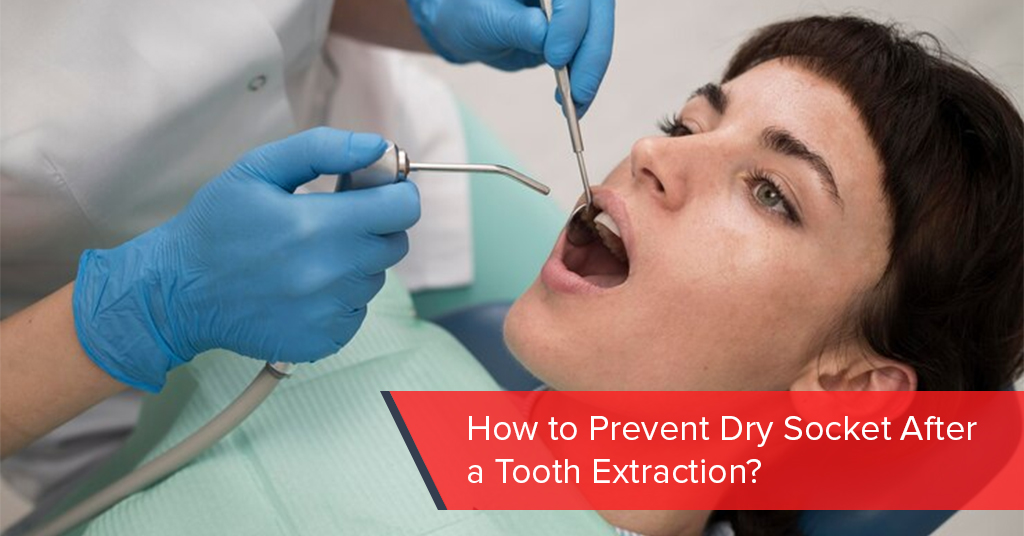Apr
How to Prevent Dry Socket After a Tooth Extraction?

You finally get rid of the toothache that has been a menace, but wait, does that mean the risk is completely gone? No, not at all. If you think tooth extraction will immediately restore your oral health, you’re mistaken. Without proper care after the extraction surgery, you might face another risk: dry socket. If you have recently undergone tooth extraction and now feel something is wrong, this blog post is just for you. It tells you about a major risk that can occur after tooth extraction, how to know if you have it, and how to prevent it. Read now.
What Is Dry Socket?
After having a tooth pulled, you might experience something called dry socket, which is pretty painful. It happens when the protective blood clot at the site either dissolves or falls out too soon, leaving the bone exposed. Following emergency tooth extraction, a fibrin clot develops within the socket, serving as a protective layer over exposed bone and neural tissue. This clot contains essential cellular components that facilitate wound healing. When it does not form properly or gets dissolved or dislodged, your tooth pulp gets exposed, leaving it at risk of infection and delayed healing.
In case you have developed this condition, you will experience the following:
- You have been experiencing severe pain 2- 3 days after wisdom tooth extraction/tooth extraction.
- Feeling pain in the ear, neck, or eye, usually on the same side as the extraction
- You can see a visible bone in the affected area and cannot spot a dark blood clot.
- You have foul taste in your mouth accompanied by bad breath
- You observe swollen lymph nodes near your jaw
If you are starting to notice these signs, you should immediately contact your dentist and get your condition inspected.
How to Prevent Dry Socket After Tooth Extraction
As we learned in the above section that dry socket arises when the blood clot forming in the healing site does not form properly, or gets displaced or dissolves. So, it’s quite obvious that you can prevent the condition. Here are some tips that can help:
1. Stick to What Your Dentist Tells You
Your dentist will give you specific recovery instructions. Following them closely can significantly reduce the risk of developing a dry socket.
2. Avoid Smoking and Tobacco Products
Avoid smoking and the use of tobacco products, as these are major risk factors for developing dry socket. The suction motion when inhaling can dislodge the blood clot. Also, the nicotine restricts blood flow, which can lead to slowing healing.
3. Skip the Straws
Using a straw might seem harmless, but it creates suction that can pull out the healing blood clot. Skip the straw for about a week to keep your recovery on track.
4. Maintain Oral Hygiene But Gently
It’s very important to keep your mouth clean after the tooth extraction, but you need to be careful. You cannot brush your teeth for at least 24 hours. After that time frame, you can rinse your mouth with lukewarm salt water (½ teaspoon salt in 8 oz of water). Try this method for several days. Please note that you cannot use mouthwash since it contains alcohol. It can irritate the wound and not let it heal.
5. Eat Soft Foods and Avoid Crunchy or Spicy Foods
Stick to a soft-food diet for the first few days to prevent irritation. Usually, the recommended foods are:
Yogurt, mashed potatoes, smoothies (no straw), soup (not too hot), applesauce.
And the foods you should avoid are:
Hard, crunchy, spicy, or sticky foods that can disturb the clot.
6. Rest and Avoid Strenuous Activity
Physical exertion can increase blood pressure, leading to bleeding or clot displacement. So, avoid labour intensive tasks such as lifting, workouts and even bending over for a few days.
7. Stay Hydrated, But Avoid Alcohol and Carbonated Drinks
– Drink plenty of water to aid healing.
– Avoid alcohol for at least 24-48 hours, as it can delay clotting.
– Carbonated drinks can dislodge the clot, so avoid them for a few days.
8. Avoid Touching the Extraction Site
Poking the area with your tongue, fingers, or any object can disrupt the healing process. Let it heal naturally.
9. Use Prescribed Medications as Directed
If your dentist prescribes antibiotics or pain medication, be sure to take them precisely as directed to help prevent infection and control pain.
What to Do If You Develop Dry Socket?
Despite precautions, dry socket can still occur. If you suspect you have it, these are the steps you have to take:
- Contact your dentist immediately. They’ll clean the area and put in a medicated dressing to help it heal faster.
- Take only the painkillers your dentist approves. Avoid aspirin because it can lead to increased bleeding.
- Continue gentle rinsing with salt water to keep the area clean.
Final Thoughts
Dry socket is a painful but preventable complication that can occur after a tooth extraction. To reduce your risk, it’s important to follow proper aftercare instructions, avoid smoking and using straws, and maintain good oral hygiene. If you’re feeling severe pain or suspect something’s wrong, go to your emergency dentist right away.
At Emergency Dental 365, we understand how challenging it can be to find dental appointments, which is why we remain open seven days a week to provide accessible emergency care for everyone in need.
By taking these precautions, you can ensure a smooth and speedy recovery after your tooth extraction. Stay mindful, follow your dentist’s advice, and prioritize your oral health!
